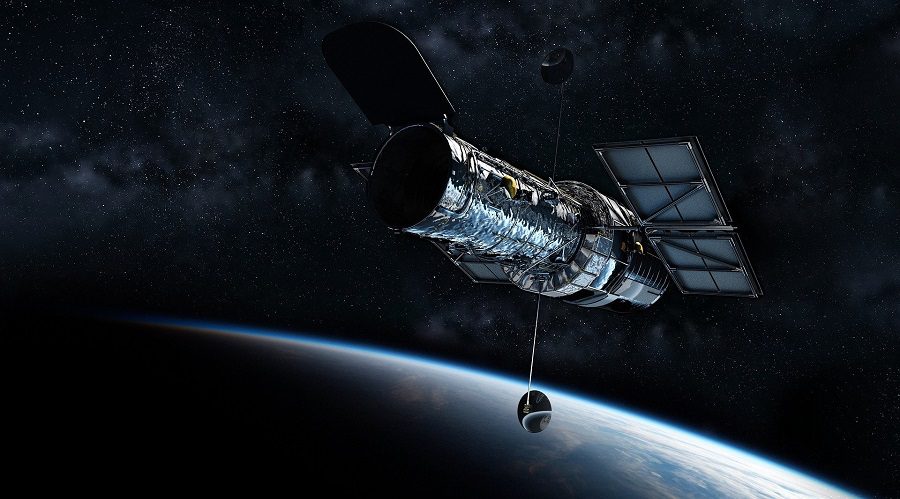What Is the Hubble Space Telescope and What Does It Do?
The Hubble Space Telescope is a massive space telescope. It was launched on April 24, 1990 into orbit by the space shuttle Discovery. Hubble orbits Earth at a distance of around 547 kilometers (340 miles). It measures the length of a huge school bus and weighs the equivalent of two adult elephants. Hubble moves at a speed of around 5 miles per second, which is equivalent to going from the east coast to the west coast of the United States in 10 minutes. Hubble is powered by solar.
Hubble captures detailed photographs of celestial objects such as planets, stars, and galaxies. More than a million observations have been made by Hubble, among them, detailed images of star formation and death, galaxies billions of light years distant, and comet fragments falling into Jupiter’s atmosphere.
These images have taught scientists a lot about the cosmos, many of which are visually appealing.
HST’s namesake, Edwin Hubble, observed that the universe is expanding and that light from distant galaxies has moved to longer, redder wavelengths, a process known as redshift, in the early 1900s. The larger the change, the greater the distance. This is due to the fact that the more distant an object is, the longer it takes for light to reach us on Earth, and the faster the universe has expanded during that time.
The Northern Hubble Deep Field, or NHDF, was created using Hubble’s ultraviolet and optical equipment, and photographs of the most distant galaxies ever seen were released in 1996. Due to redshift, which had moved all of the light from the most distant galaxies out of the visible and into the infrared, these images had reached their distance limit.
The Near Infrared Camera and Multi-Object Spectrometer, NICMOS, pronounced “Nick Moss,” is one of the new instruments mounted on Hubble during the second maintenance mission. The NICMOS near-infrared cameras studied NHDF zones and identified even more distant galaxies with all of their light in the near infrared.
Hubble’s Law and the expanding universe
Edwin Hubble’s 1929 PNAS article on the observed link between distance and recession velocity of galaxies, known as the Hubble Law, revealed the expanding universe and permanently revolutionized our knowledge of the cosmos. It was the first step in the study of observational cosmology, which has revealed a massive universe that has been expanding and changing for 14 billion years and contains dark matter, dark energy, and billions of galaxies.
It’s hard to believe that only 90 years ago, we had no idea that most of the cosmos around us existed. The fact of a very huge, ancient, expanding universe, packed with billions of galaxies receding from one another as cosmic space expands billions of years ago, is so evident from today’s perspective that we anticipate it to have been known for millennia. That is not the case. The key 1929 PNAS publication “A relation between distance and radial velocity among extra-galactic nebulae” (1) by Edwin Hubble was a watershed moment in our knowledge of the cosmos. Hubble offered the observational evidence for one of science’s biggest discoveries—the expanding universe—in his brief report. Galaxies are retreating away from us at a rate proportionate to their distance from us, as Hubble discovered: more distant galaxies recede faster than closer galaxies.
Hubble’s launch ushered in the discipline of observational cosmology, revealing a huge and majestic cosmos to be studied. Observations of the universe’s large-scale structure, clusters of galaxies, SNIa, and cosmic microwave background radiation have revealed an amazing universe: a flat (zero spatial curvature) universe with 5% baryons (stars, gas), 25% exotic non baryonic dark matter, and 70% dark energy that causes the universe’s current expansion rate. The astounding discovery of cosmic acceleration was obtained in 1998 (9–12) using a distance indicator approach similar to Hubble’s, but using the extremely luminous SNIa as precise standard candles to estimate the development of the expansion rate (the Hubble Diagram) at large distances (early cosmic times). The unexpected finding revealed that the pace of growth has accelerated in the last 6 billion years. The enigmatic dark energy that generates this acceleration has yet to be discovered. Is it the cosmological constant, which represents the vacuum’s energy density, or something else? This is one of today’s most fundamental cosmological problems. The search for an answer to this question is now under progress. The Hubble Space Telescope, among others, is now employing SNIa to observe the Hubble Law at larger distances in order to track the detailed evolution of the expanding universe. Due to the unique cosmology of the universe, including the cosmic mass density (whose gravity slows the expansion) and the amount and form of dark energy, the linear relationship found at small distances begins to deviate from linearity at enormous distances (which accelerates the expansion).
























